Vim (text editor)
Vim (/vɪm/;[2] a contraction of Vi IMproved) is a clone, with additions, of Bill Joy's vi text editor program for Unix. Vim's author, Bram Moolenaar, based it on the source code for a port of the Stevie editor to the Amiga[3] and released a version to the public in 1991. Vim is designed for use both from a command-line interface and as a standalone application in a graphical user interface. Vim is free and open-source software and is released under a license that includes some charityware clauses, encouraging users who enjoy the software to consider donating to children in Uganda.[4] The license is compatible with the GNU General Public License through a special clause allowing distribution of modified copies "under the GNU GPL version 2 or any later version".[5]
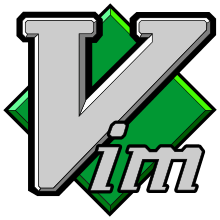 | |
-console.png) Vim running in a terminal emulator | |
| Original author(s) | Bram Moolenaar |
|---|---|
| Initial release | 2 November 1991 |
| Stable release | 8.2.0000[1] (13 December 2019) [±] |
| Repository | |
| Written in | C, Vim script |
| Operating system | Unix, Linux, Windows NT, MS-DOS, macOS, iOS, Android, Haiku, AmigaOS, MorphOS |
| Type | Text editor |
| License | Free software (Vim License), charityware |
| Website | www |
Since its release for the Amiga, cross-platform development has made it available on many other systems. In 2006, it was voted the most popular editor amongst Linux Journal readers;[6] in 2015 the Stack Overflow developer survey found it to be the third most popular text editor,[7] and the fifth most popular development environment in 2019.[8]
History
Vim's forerunner, Stevie (ST Editor for VI Enthusiasts), was created by Tim Thompson for the Atari ST in 1987[9][10] and further developed by Tony Andrews[9][11] and G.R. (Fred) Walter.[12][13]
Basing his work on Stevie, Bram Moolenaar began working on Vim for the Amiga computer in 1988, with the first public release (Vim v1.14) in 1991.[14][15]
At the time of its first release, the name "Vim" was an acronym for "Vi IMitation", but this changed to "'Vi IMproved" late in 1993.[16]
Release history | |||||||||||||||||||||||||||||||||||||||||||||||||||||||||||||||||||||||||||||||||||||||||||||
|---|---|---|---|---|---|---|---|---|---|---|---|---|---|---|---|---|---|---|---|---|---|---|---|---|---|---|---|---|---|---|---|---|---|---|---|---|---|---|---|---|---|---|---|---|---|---|---|---|---|---|---|---|---|---|---|---|---|---|---|---|---|---|---|---|---|---|---|---|---|---|---|---|---|---|---|---|---|---|---|---|---|---|---|---|---|---|---|---|---|---|---|---|---|
|
Interface
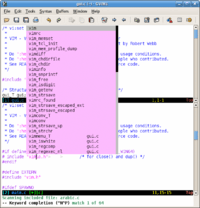
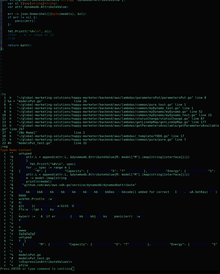
Like vi, Vim's interface is not based on menus or icons but on commands given in a text user interface; its GUI mode, gVim, adds menus and toolbars for commonly used commands but the full functionality is still expressed through its command line mode. Vi (and by extension Vim) tends to allow a typist to keep their fingers on the home row, which can be an advantage for a touch typist.[29]
Vim has a built-in tutorial for beginners called vimtutor. It's usually installed along with Vim, but it exists as a separate executable and can be run with a shell command.[30] There is also the Vim Users' Manual that details Vim's features and a FAQ. This manual can be read from within Vim, or found online.[31][32]
Vim also has a built-in help facility (using the :help command) that allows users to query and navigate through commands and features.
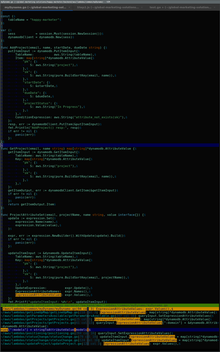
Modes
Vim has 12 different editing modes, 6 of which are variants of the 6 basic modes.[33] The basic modes are:
- Normal mode - used for editor commands. This is also the default mode, unless the
insertmodeoption is specified. - Visual mode - similar to normal mode, but used to highlight areas of text. Normal commands are run on the highlighted area, which for an instance can be used to move or edit a selection.
- Select mode - works similarly to visual mode. However, if a printable character, carriage return, or newline (or line feed) is entered, Vim inserts the character, and starts insert mode.[34]
- Insert mode - similar to editing in most modern editors. In insert mode, buffers can be modified with the text inserted.
- Command-line or Cmdline mode - supports a single line input at the bottom of the Vim window. Normal commands (beginning with
:), and some other specific letters corresponding to different actions (including pattern search and the filter command) activate this mode. - Ex mode - similarly to Cmdline mode, it takes a single line input at the bottom of the window. However, in Cmdline mode, entering a command exits the mode when the command is executed. Entering a command in Ex mode doesn't cause the mode to change.
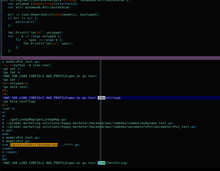
Customization
Vim is highly customizable and extensible, making it an attractive tool for users who demand a large amount of control and flexibility over their text editing environment.[35] Text input is facilitated by a variety of features designed to increase keyboard efficiency. Users can execute complex commands with "key mappings," which can be customized and extended. The "recording" feature allows for the creation of macros to automate sequences of keystrokes and call internal or user-defined functions and mappings. Abbreviations, similar to macros and key mappings, facilitate the expansion of short strings of text into longer ones and can also be used to correct mistakes. Vim also features an "easy" mode for users looking for a simpler text editing solution.[36]
There are many plugins available that extend or add new functionality to Vim, such as linters, integration with Git, showing colors in CSS. These complex scripts are usually written in Vim's internal scripting language, vimscript (also known as VimL),[37] but can be written in other languages as well.
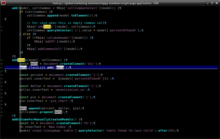
There are projects bundling together complex scripts and customizations and aimed at turning Vim into a tool for a specific task or adding a major flavour to its behaviour. Examples include Cream, which makes Vim behave like a click-and-type editor, or VimOutliner, which provides a comfortable outliner for users of Unix-like systems.
Features and improvements over vi
Vim has a vi compatibility mode, but when that mode isn't used, Vim has many enhancements over vi.[38] However, even in compatibility mode, Vim is not entirely compatible with vi as defined in the Single Unix Specification[39] and POSIX (e.g., Vim does not support vi's open mode, only visual mode). Vim has nevertheless been described as "very much compatible with Vi".[40]
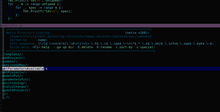
Some of Vim's enhancements include completion, comparison and merging of files (known as vimdiff), a comprehensive integrated help system, extended regular expressions, scripting languages (both native and through alternative scripting interpreters such as Perl, Python, Ruby, Tcl, etc.) including support for plugins, a graphical user interface (known as gvim), limited integrated development environment-like features, mouse interaction (both with and without the GUI), folding, editing of compressed or archived files in gzip, bzip2, zip, and tar format and files over network protocols such as SSH, FTP, and HTTP, session state preservation, spell checking, split (horizontal and vertical) and tabbed windows, Unicode and other multi-language support, syntax highlighting, trans-session command, search and cursor position histories, multiple level and branching undo/redo history which can persist across editing sessions, and visual mode.
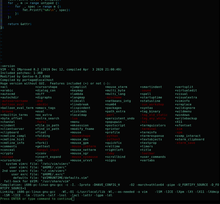
Vim script
Vim script (also called vimscript or VimL)[41] is the scripting language built into Vim.[42] Based on the ex editor language of the original vi editor, early versions of Vim added commands for control flow and function definitions. Since version 7, Vim script also supports more advanced data types such as lists and dictionaries and (a simple form of) object-oriented programming. Built-in functions such as map() and filter() allow a basic form of functional programming, and Vim script has lambda since version 8.0. Vim script is mostly written in an imperative programming style.
Vim macros can contain a sequence of normal-mode commands, but can also invoke ex commands or functions written in Vim script for more complex tasks. Almost all extensions (called plugins or more commonly scripts) of the core Vim functionality are written in Vim script, but plugins can also utilize other languages like Perl[43], Python[44], Lua[45], Ruby[46], Tcl[47], or Racket.[48] These plugins can be installed manually, or through a plugin manager such as Vundle, Pathogen, or Vim-Plug.
Vim script files are stored as plain text, similarly to other code, and the filename extension is usually .vim. One notable exception to that is Vim's config file, .vimrc.
Examples
" This is the Hello World program in Vim script.
echo "Hello, world!"
" This is a simple while loop in Vim script.
let i = 1
while i < 5
echo "count is" i
let i += 1
endwhile
unlet i
Availability
Whereas vi was originally available only on Unix operating systems, Vim has been ported to many operating systems including AmigaOS (the initial target platform), Atari MiNT, BeOS, DOS, Windows starting from Windows NT 3.1, OS/2, OS/390, MorphOS, OpenVMS, QNX, RISC OS, Linux, BSD, and Classic Mac OS.[49] Also, Vim is shipped with every copy of Apple macOS.[50]
Independent ports of Vim are available both for Android[51][52] and iOS.[53]
Neovim


Neovim[54] is a fork – with additions[55] – of Vim that strives to improve the extensibility and maintainability of Vim.[56] Neovim shares the same configuration syntax with Vim; as a result, the same configuration file can be used with both editors, although there are minor differences between the exact options used between the two.[57] If the added features of Neovim are not used, Neovim is compatible with almost all of Vim's features.[58]
The Neovim project was started in 2014, with some Vim community members offering early support of the high-level refactoring effort to provide better scripting, plugins, and integration with modern GUIs .[59][60] The project is free software and its source code is available on GitHub.[61]
Neovim had a successful fundraiser on 23 March 2014,[62] supporting at least one full-time developer. Several frontends are under development, making use of Neovim's capabilities.[63][64][65]
The Neovim editor is available in Ubuntu's PPAs,[66] and several other package managers,[67] making it possible to install on a variety of operating systems.
See also
- Learning the vi and Vim Editors, a tutorial book for vi and vim, published by O'Reilly Media.
- Editor war – the rivalry between users of the Emacs and vi (Vim) text editors
- List of text editors
- Comparison of text editors
- Vimperator
- Pentadactyl
- Vimium
References
- "Releases". Retrieved 13 December 2019 – via GitHub.
- Vim documentation: intro: "Vim is pronounced as one word, like Jim, not vi-ai-em. It's written with a capital, since it's a name, again like Jim."
- Zapletal, Lukáš (April 18, 2005), "Interview: Bram Moolenaar", LinuxEXPRES: 21–22, retrieved February 5, 2015,
Is VIM derivate of other VI clone or you started from scratch? I started with Stevie. This was a Vi clone for the Atari ST computer, ported to the Amiga. It had quite a lot of problems and could not do everything that Vi could, but since the source code was available I could fix that myself. (English translation)
- "Vim documentation: uganda". vimhelp.org.
- "Vim documentation: uganda".
- "Linux Journal: 2003 Readers' Choice Awards". 2003-11-01. Retrieved 2006-05-24.; "Linux Journal: 2004 Readers' Choice Awards". 2004-11-01. Retrieved 2006-05-24.; "Linux Journal: 2005 Readers' Choice Awards". 2005-09-28. Retrieved 2006-05-24.
- "Stack Overflow Developer Survey 2015 § IV. Text Editor". Stack Overflow. Retrieved July 25, 2016.
- "Stack Overflow Developer Survey 2019 Results". Stack Overflow § VII. Development Environments. Retrieved July 20, 2019.
- Thompson, Tim (2000-03-26). "Stevie". Retrieved 2010-12-27.
- Tim Thompson (1987-06-28). "A mini-vi for the ST". Newsgroup: comp.sys.atari.st. Usenet: 129@glimmer.UUCP. Retrieved 2010-12-27.
- Tony Andrews (1988-06-06). "v15i037: Stevie, an "aspiring" VI clone for Unix, OS/2, Amiga". Newsgroup: comp.sources.unix. Usenet: 893@fig.bbn.com. Retrieved 2010-12-27.
- Vim (20 January 2015). "intro.txt". Vim Help. Vim. Archived from the original on 9 July 2016. Retrieved 9 July 2016.
- "vim(1)". die.net. Vim. 11 April 2006. Archived from the original on 9 July 2016. Retrieved 9 July 2016.
Vim is based on Stevie, worked on by: Tim Thompson, Tony Andrews and G.R. (Fred) Walter. Although hardly any of the original code remains.
- "The continuing story of Vim" (PDF).
- "The history of Vim - Jovica Ilic". Retrieved 25 January 2020.
- "VILE (Vi Like Emacs) – Frequently Asked Questions (FAQ)". Retrieved 7 September 2019.
- Moolenaar, Bram (2002-01-15). "Vim, an open-source text editor". Retrieved 2005-10-24.
- "Textfiles.com".
- "Filewatcher". Archived from the original on July 11, 2011. Retrieved February 26, 2011.
- "Official Vim Manual, Version 4 summary". 2004-03-12. Retrieved 2008-08-06.
- "Official Vim Manual, Version 5 summary". 2004-01-17. Retrieved 2008-08-06.
- "Official Vim Manual, Version 6 summary". 2004-03-12. Retrieved 2008-08-06.
- "Vim Reference Manual, Version 7". 2016-07-17. Retrieved 2019-01-13.
- "Google Groups". groups.google.com.
- Google Discussiegroepen. Groups.google.com. Retrieved on 2013-12-09.
- Bram Moolenaar. "Vim 8.0 released!". Retrieved September 12, 2016.
- Bram Moolenaar. "Vim 8.1 is released!". Retrieved May 18, 2018.
- Bram Moolenaar. "Vim 8.2 is released!". Retrieved December 13, 2019.
- Lamb, Linda; Robbins, Arnold (1998). Learning the Vi Editor. O'Reilly Media, Inc. p. 305. ISBN 9781565924260.
- Moolenaar, Bram (3 November 2010). "Vim documentation: usr_01". Retrieved 28 August 2019.
- Vim help files at vimhelp.org
- Oualline, Steve (April 2001). Vi IMproved (VIM) (PDF). New Riders Publishers. ISBN 0-7357-1001-5.
- Moolenaar, Bram (8 December 2010). "Vim documentation: intro". vimdoc.sourceforge.net. Retrieved 2019-08-28.
- Moolenaar, Bram (17 February 2010). "Vim documentation: visual". vimdoc.sourceforge.net. Retrieved 2019-08-28.
- Melendez, Steven. "Why Vim, An '80s Text Editor, Is Still The UI Of Choice For Power Users". FastCompany. Retrieved May 5, 2019.
- "Tips: Making Vim easy". Linux.com. 2007-04-10. Retrieved 6 May 2019.
- "Vim documentation: usr_41". vimhelp.org.
- Vim help system (type "
:help" within Vim) - The Open Group (2008), "vi — screen-oriented (visual) display editor", Single Unix Specification, Version 4 (IEEE Std 1003.1-2008), retrieved 2010-12-27
- Peppe, Benji, Charles Campbell (2004-01-02). "Vim FAQ". Retrieved 2010-12-27.CS1 maint: multiple names: authors list (link) (question 1.3)
- Klein, Benjamin. "The VimL Primer: Edit Like a Pro with Vim Plugins and Scripts by Benjamin Klein | The Pragmatic Bookshelf". Retrieved 25 January 2020.
- "Vim documentation: usr_41". vimhelp.org.
- Verdoolaege, Sven; Gerassimof, Matt. "Vim documentation: if_perl". Retrieved 2019-08-27.
- Moore, Paul. "Vim documentation: if_pyth". Retrieved 2019-08-27.
- Carvalho, Luis. "Vim documentation: if_lua". Retrieved 2019-08-27.
- Maeda, Shugo. "Vim documentation: if_ruby". Retrieved 2019-08-27.
- Wilken, Ingo. "Vim documentation: if_tcl". Retrieved 2019-08-27.
- Khorev, Sergey. "Vim documentation: if_mzsch". Retrieved 2019-08-27.
- "
:help sys-file-list"
"Vim Online: Downloads". Retrieved 2007-01-07. - "Mac OS X Manual Page For vim(1)". developer.apple.com. Apple Inc. Retrieved 2010-01-12.
- "VimTouch, the development has stalled on this app". Retrieved 2015-08-09.
- "DroidVim, under active development". Retrieved 2017-03-05.
- "Vim - Applidium, mobile agency in Paris". Archived from the original on 2012-01-20. Retrieved 2015-08-11.
- "Neovim: vim, out of the box".
- "Nvim documentation: vim_diff".
- "Neovim Vision".
- "Switching to NeoVim".
- "How to start using Neovim instead of Vim".
- "Neovim: Rebuilding Vim For the 21st Century".
- "Vimcasts.org blog post".
- "GitHub - neovim/neovim: Vim-fork focused on extensibility and usability". 2019-08-29.
- "Bountysource fundraiser".
- "NyaoVim frontend". 2019-08-29.
- "Mac OS X frontend". 2019-08-29.
- "Neovim-Qt frontend". 2020-07-21.
- "Neovim PPA information".
- "Neovim wiki: installation instructions". 2019-08-29.
External links
| The Wikibook Learning the vi Editor has a page on the topic of: Vim |
| Wikimedia Commons has media related to Vim. |